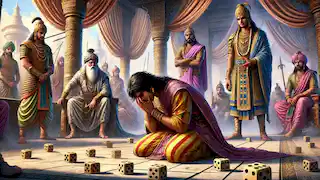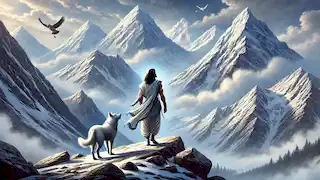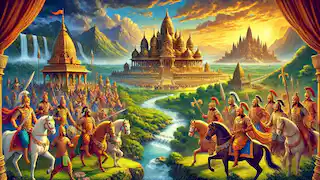{{{_intro}}}
The Mahabharata is one of the two great epics of ancient India, the other being the Ramayana. Composed over several centuries and with contributions from many authors, this monumental work is a tale of conflict, morality, duty, and the complexity of human relationships. At its heart lies the narrative of the Kurukshetra War, fought between two branches of the Kuru dynasty: the Pandavas and the Kauravas. However, the Mahabharata is much more than just a war epic. It contains numerous stories, discourses, and teachings that touch upon every aspect of human life. It delves into philosophy, statecraft, devotion, and the eternal struggle between dharma (righteousness) and adharma (unrighteousness).
The epic’s complexity makes it not just a story of the past but a timeless guide for individuals in understanding life’s trials and challenges. It presents both heroes and villains, none of whom are entirely perfect or wholly evil, making the Mahabharata a true reflection of the human experience.
The Prelude
The story begins with the ancestors of the Kuru dynasty. Bharata, a renowned king, was the first to establish the line, and it was his descendants who came to rule the great kingdom of Hastinapura. Among these descendants were King Shantanu and his wife, Ganga, the river goddess. Their union produced a son, Devavrata, who would later become known as Bhishma.
Bhishma, one of the central figures in the epic, took a terrible vow of celibacy to ensure his father could marry Satyavati, a fisherwoman. This vow earned him the title of Bhishma, which means "the one who undertakes a terrible vow." His oath ensured that Satyavati’s sons, not his own, would inherit the throne of Hastinapura.
However, tragedy struck when both of Satyavati’s sons, Chitrangada and Vichitravirya, died without leaving heirs. Bhishma, bound by his vow, could not ascend the throne. To resolve the crisis, Satyavati called upon her son Vyasa, the sage who had composed the Mahabharata, to father sons with the widows of Vichitravirya. Thus were born Dhritarashtra, Pandu, and Vidura.
Dhritarashtra was born blind, and therefore Pandu became the king of Hastinapura. Dhritarashtra, though blind, had a hundred sons with his wife Gandhari. These sons were the Kauravas, with Duryodhana as their leader. Pandu, on the other hand, had five sons: Yudhishthira, Bhima, Arjuna, Nakula, and Sahadeva. These sons were called the Pandavas.
The Rivalry Begins
The rivalry between the Pandavas and the Kauravas began in their childhood. Duryodhana, the eldest Kaurava, was intensely jealous of the Pandavas, especially Yudhishthira, who was the rightful heir to the throne. Though they were cousins, the hostility between them grew with time, spurred on by Duryodhana’s desire for power and his father Dhritarashtra’s partiality to his own sons.
The Pandavas were trained in warfare by the great teacher Dronacharya, alongside the Kauravas. Arjuna, the third Pandava, excelled in archery and became Dronacharya’s favorite disciple. Duryodhana, however, grew increasingly resentful of the attention and praise Arjuna received.
In an effort to rid themselves of the Pandavas, Duryodhana and his uncle Shakuni devised a plan to burn them alive in a palace made of lac, a highly flammable material. However, the Pandavas, warned by Vidura, escaped the trap and went into hiding.
While in exile, they lived among commoners and even married. Arjuna won the hand of Draupadi, the princess of Panchala, in a contest of skill. Draupadi, however, became the shared wife of all five Pandavas, a unique and controversial arrangement in the epic.
The Game of Dice
After several years in exile, the Pandavas returned to Hastinapura, where Yudhishthira was crowned as the crown prince. However, Duryodhana’s jealousy did not subside. Shakuni, his uncle, proposed a game of dice to Duryodhana, knowing that Yudhishthira had a weakness for gambling.

Yudhishthira accepted the invitation, and what followed was a catastrophe for the Pandavas. Shakuni, who was a master at deceit, used loaded dice to ensure the Pandavas' defeat. One by one, Yudhishthira lost all his wealth, his kingdom, and eventually, his brothers and even Draupadi herself. Draupadi, now a queen, was humiliated in the court of Hastinapura, where Duryodhana tried to disrobe her. However, by divine intervention, her dignity was saved.
This event, known as the "Game of Dice," is one of the turning points in the Mahabharata. It sets the stage for the final confrontation between the Pandavas and the Kauravas.
As a result of losing the game, the Pandavas were forced into exile for 13 years, with the final year to be spent in anonymity. If discovered during this last year, they would have to repeat their exile. Thus began another period of hardship for the Pandavas, but during this time, they prepared themselves for the inevitable war.
The Kurukshetra War
After their exile, the Pandavas returned to claim their rightful share of the kingdom. However, Duryodhana refused to part with even a single village. With negotiations failing, war became inevitable. Both sides began amassing their armies. Krishna, the prince of Dwarka, who was a cousin and dear friend to the Pandavas, offered his help to both sides. He gave Duryodhana the choice between himself as an advisor without taking up arms and his mighty army. Duryodhana, in his arrogance, chose Krishna’s army, while Arjuna, wisely, chose Krishna’s counsel.
Thus, Krishna became Arjuna’s charioteer during the war, guiding him through the moral and ethical dilemmas he would face.
The Kurukshetra War was fought for 18 days, with numerous heroes and warriors from both sides meeting their fate on the battlefield. Bhishma, Dronacharya, Karna, and countless other warriors fought valiantly for the Kauravas, while the Pandavas had allies like Draupadi’s brother Dhrishtadyumna and the mighty Ghatotkacha, Bhima’s son.

The battle was not just a clash of arms but also a battle of dharma. Krishna, acting as Arjuna’s guide, delivered the Bhagavad Gita, a discourse on life, duty, and righteousness, in the midst of the battlefield. Arjuna, seeing his kinsmen on the opposing side, hesitated to fight. But Krishna reminded him of his duty as a warrior and the impermanence of life. The Gita has since become one of the most important philosophical texts in the world.
The Fall of Heroes
As the war raged on, both sides suffered immense losses. Bhishma, who had taken a vow to serve the throne of Hastinapura, fought on the side of the Kauravas, though he did not approve of Duryodhana’s actions. Bhishma was eventually brought down by Arjuna, who, on Krishna’s advice, used Shikhandi, a warrior whom Bhishma refused to fight because of a past enmity.
After Bhishma’s fall, Dronacharya took command of the Kaurava forces. However, he too met his end when Yudhishthira, known for never telling a lie, deceived him into believing that his son Ashwatthama was dead. Overcome with grief, Dronacharya laid down his arms and was killed.
Karna, the tragic hero of the Mahabharata, fought on the side of the Kauravas, even though he was the eldest Pandava by birth. Karna had been abandoned by his mother Kunti at birth and was raised by a charioteer. Despite learning of his true lineage, he remained loyal to Duryodhana, who had been his only friend and benefactor. Karna’s death at the hands of Arjuna is one of the most poignant moments of the epic, symbolizing the tragedy of divided loyalties.

The war ended with the death of Duryodhana, who was defeated by Bhima in a fierce battle. With the Kauravas annihilated, the Pandavas emerged victorious, but it was a hollow victory. The battlefield of Kurukshetra was strewn with the bodies of countless warriors, and the Pandavas, too, were left mourning the loss of their loved ones.
Aftermath and the Ascent to Heaven
With the war over, Yudhishthira was crowned the king of Hastinapura. However, the victory came at a great personal cost. The Pandavas were haunted by the memories of the war and the lives lost. Yudhishthira, in particular, was consumed by guilt for the destruction caused. In an effort to atone for their sins, the Pandavas decided to renounce their kingdom and embark on a journey to the Himalayas, seeking peace and liberation.
As they climbed the mountains, one by one, the Pandavas fell, leaving only Yudhishthira to reach the summit. Accompanied by a dog, who was none other than the god Dharma in disguise, Yudhishthira was taken to heaven in his mortal form, the only one among the Pandavas to achieve this honor.
In heaven, Yudhishthira was reunited with his brothers and Draupadi. The epic concludes with the restoration of dharma and the fulfillment of divine justice.
Legacy of the Mahabharata
The Mahabharata, with its intricate plots, larger-than-life characters, and profound moral lessons, remains one of the most influential works of literature in the world. It is not merely a story of a war but a meditation on the human condition, exploring the themes of duty, righteousness, loyalty, and the complexities of life.

From the Bhagavad Gita to the countless sub-stories embedded within, the Mahabharata offers wisdom that transcends time and place. It speaks to the eternal struggle between good and evil, the importance of making difficult choices, and the consequences of those choices.
Even today, the Mahabharata continues to inspire readers, scholars, and thinkers across the world, reminding us that life’s greatest battles are often fought within.

















